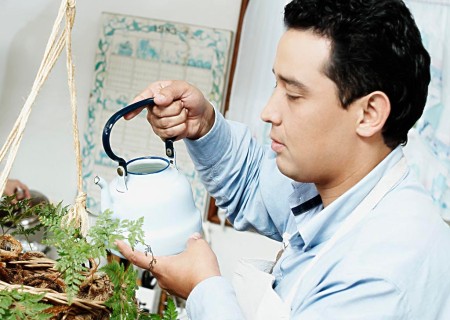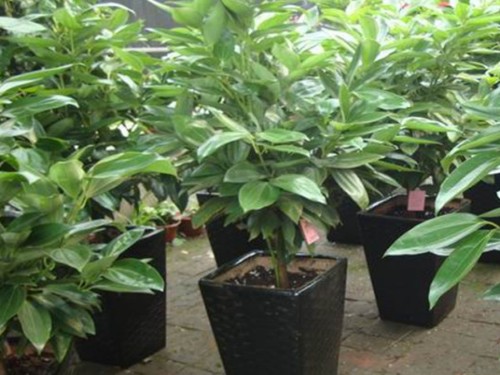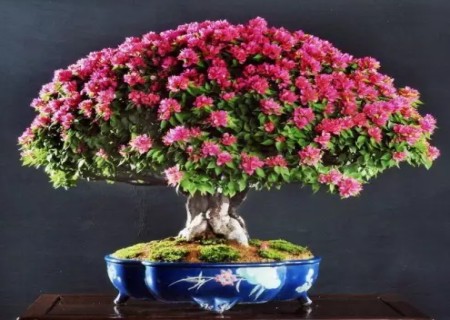How to water bonsai-watering method of bonsai
The most complicated step to take care of the bonsai is to water it properly. The frequency of watering trees depends on several factors, such as tree species, tree size, flowerpot size, season, soil composition and climate. Therefore, it is basically impossible to point out the correct frequency. However, knowing the following basic guidelines can help you observe when, how and how much trees need to be watered.
The maintenance and management of bonsai, watering is a regular work, the most technical, different plants, different types of bonsai, different nature of soil, watering times and water quantity should be different.

1. Watering time
When will it be watered? In fact, the watering time does not need to be too important, but try to avoid it in the afternoon, because the temperature of the soil rises after exposure to sunlight and cools quickly when it comes into contact with cold water. When the soil is a little dry, water the trees. That is to say, the soil should not be watered when the soil is still wet, but only when the soil is slightly dry. You can insert your finger into the soil about one centimeter (0.4 inch) to check. As you gain experience, you will be able to observe with the naked eye (rather than by touch) when trees need to be watered.
2. Watering method
How to water it? As mentioned above, trees should be watered only when the soil is slightly dry. When trees need watering, they need to soak their roots thoroughly to keep them moist. To achieve the above effect, water until the water seeps out of the drain hole and do it again after ten minutes.
Use a kettle with a thinner nozzle to water over the trees to avoid washing away the soil. The effect of using the collected Rain Water is better because it does not contain added chemicals, but when Rain Water is not easy to collect, it is no problem to use normal plumbing water. Be careful not to water regularly, but you need to get into the habit of observing each tree instead of watering it every day.
1) bottom irrigation method
Put 3-5 cm of water in a washbasin and put the flowerpot in so that the water moistens the soil through the bottom of the basin. This is good for preventing soil consolidation and promoting root development. When the bonsai is flooded, the water surface should be under the edge of the bonsai and be taken out when the topsoil is wet.
2) Sand column method
In the flower basin or change the basin, first in the empty basin neutral a few hollow pipes (such as bamboo tube, iron pipe, etc.), and then fill the soil compaction, and then fill the pipe with coarse sand, and finally pull out the empty tube, the basin will form a sand column, after water injection, water only through the sand column spread around, can avoid soil consolidation.
3) Fiber water absorption method
A cloth strip or fiber suction rope can be buried in the basin, and one end of the cloth strip or rope can be placed in the water of the chassis. By using the capillary water absorption of the cloth strip or rope, the water can be absorbed into the basin from the chassis to keep the basin soil moist. If the master is out for several days, this method can be used when no one is watering.
4) Water spraying method
The need for air temperature for flowers and trees is by no means equal to its requirement for soil moisture. The air temperature is not enough, especially the bonsai environment is too dry, the appearance of plants is not bright, new branches and leaves are also lifeless, so it is often necessary to spray water on flowers. For example, the place where bonsai is placed is often sprayed with water, which increases the humidity of the environment and microclimate, which is very good for bonsai maintenance.
3. Watering frequency
Bonsai should use a suitable soil mixture, and the soil composition has a profound influence on the frequency of watering trees. For most bonsai trees, the soil composed of red jade soil, gravel and compost (the ratio is 2:1:1) works well. However, if you cannot water on time, use a soil mixture that is more resistant to water loss (higher compost content).
As mentioned above, the frequency of watering depends on too many factors to produce an accurate schedule. However, you need to learn to observe your trees and know when to water them. Follow the above basic guidelines and hope to help you water the bonsai correctly.
4. Water quantity
Different flowers have different water requirements, so watering varies from flower to flower. Common cactus and flowers such as aloe and sedum are underdeveloped and should be watered less. Some flowers and trees, there is a layer of dense villi on the leaves, such as begonia, paulownia, Baobao flowers, etc., it is not suitable to spray water on the leaves, otherwise the water is difficult to evaporate, mildew and disease easily.
There are many flowers with small leaves, slow evaporation of water and less watering to blossom more, such as crape myrtle, Jiuli incense, sparrow plum and so on. In addition, flowers and trees should be watered more in the peak growing season and in the bud period, and less in the flowering period. Freshly trimmed flowers should be watered less, otherwise the branches and leaves will be empty and affect the shape.
Time: 2019-06-10 Click:
- Prev

Propagation methods of potted safe trees
Ping an tree is a kind of bright green and auspicious Lanyu cinnamon (cinnamon, ping an tree). Ping an tree is the elegant name of Orchid Island cinnamon. It has the role of potted ornamental plants, is one of the common family foliage plants, air conditioning is very good! People gave it an auspicious name, Ping an Tree.
- Next

How to trim triangular plum bonsai-trimming method of triangular plum bonsai
To the annual flowering season, the triangular plums dotted in the green leaves are burning like clusters of flames, like butterflies of different colors dancing, and the golden sun smears a layer of light gold on the petals, emitting the vitality of life. Triangular plum, also known as rhododendron and Pueraria lobata, is extremely beautiful.
Related
- Fuxing push coffee new agricultural production and marketing class: lack of small-scale processing plants
- Jujube rice field leisure farm deep ploughing Yilan for five years to create a space for organic food and play
- Nongyu Farm-A trial of organic papaya for brave women with advanced technology
- Four points for attention in the prevention and control of diseases and insect pests of edible fungi
- How to add nutrient solution to Edible Fungi
- Is there any good way to control edible fungus mites?
- Open Inoculation Technology of Edible Fungi
- Is there any clever way to use fertilizer for edible fungus in winter?
- What agents are used to kill the pathogens of edible fungi in the mushroom shed?
- Rapid drying of Edible Fungi

